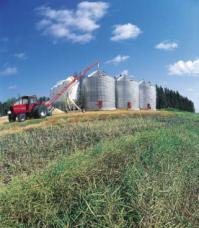Jian Zhang came to Canada from China almost fifteen years ago to study biotechnology at the University of Guelph in Guelph, Ontario.
Zhang still lives in Canada, working as a research scientist for the Alberta Research Commission (ARC), and has been instrumental in developing a partnership between his native and adopted countries to reduce phosphorous emissions in livestock waste while adding value to canola seed. The ARC and the Shanghai Academy of Agricultural Science (SAAS) are using genetic technology to buffer the harsh and toxic realities of animal waste production by introducing an enzyme to the canola seed which aids the digestion of the phytate molecule, which contains phosphorous.
Canada currently has a stable annual production of approximately 7 million tonnes of canola seed per year, and much of that output is exported. Through the genetic modification of canola, Zhang says feed scientists can add value to canola feed by encouraging the utilisation of phosphates within animals, “stimulating the metabolism of the compound in their own systems, and decreasing the levels of the harmful agent in their waste.”
Canola crushing is a major industry in western Canada, and one that the country is looking to expand, as demand for animal feed and cooking oils around the world grows all the time. One way to grow export markets is to offer a superior project. “If the animal can break down phytate in the canola, and it can be utilised nutritionally, then feeders no longer need to add the phytase enzyme as an ingredient,” Zhang says. “This increases the value of canola and it decreases the cost of feed.”
Improving availability
Similar to other vegetable sources where phosphorous is present as phytate, the amount available for digestion is
estimated to be between 30 and 50% of the total phosphorus level, which is what Zhang’s research looks to improve. So far during the 2008/09 crop year, which started on August 1, Canada has exported 304,000 tonnes of canola meal and 177,000 tonnes of canola oil, but none has gone to China, says the Cereals and Oilseed Review for Statistics Canada. Canada, through projects like the CAN$1.4 million (€865,000) genetic modification project between the ARC and SAAS, is looking to expand its market for canola in China. Because China grows a rapeseed variety that is inferior to canola, scientists in Shanghai are looking to increase the country’s own canola cultivating expertise by working with Canada, the world’s leading producer.
“The value of canola being shipped from Alberta to China increases almost three-fold with the implementation of this technology,” says Zhang, once a research associate at both the Chinese Academy of Science in Beijing and the Biotech Division of the department of plant agriculture at the University of Guelph. “That will encourage trade.”
Technology, collaboration, reaction
Sage Biosciences, a feed additive technology company located in Edmonton, Alberta, has worked with ARC for several years on various topics and recently became involved with the phytase gene expression project. Lyle Rode, chief science officer for Sage Biosciences says when institutions with special areas of expertise cooperate on solving a problem, the power and knowledge of the effort builds. Certainly, a scientific project to modify animal diets can be very complex.
“The conditions have to be right for the animal to absorb certain nutrients during digestion, so there is a lot more to the success of this project than simply managing the genetic modification on the canola,” Rode tells Feed Tech. “Sage Biosciences is contributing nutritional advice, while the ARC and those in Shanghai are handling the laboratory tasks of protein expression and gene manipulation.”
The macro mineral phosphorous is an essential nutrient for livestock, health, growth and development. Often, however, it is not readily available for the animal to absorb through digestion. Therefore, producers often need expensive enzyme additives to help the animal break down the phytate molecule of which phosphorous is a part. “The phosphorous is wrapped up in that molecule and it can’t be digested,” Rode says. Because there isn’t a naturally occurring phytase enzyme in canola, genetic researchers in Alberta and Shanghai are trying to modify genes so that seeds will express the protein needed to metabolise the phytate molecule. “Phytase is a virtually required additive in Europe,” Rode says, “because it allows animals to digest phosphorous so that a lesser amount is contained in the waste which can wash into water supplies and cultivation lands.”
Even though genetic manipulation scientists are often involved with work to reduce the footprint of industrial farming they manipulate naturally occurring plants. There is a anxiety over the unknown and a “Frankenstein- like” fear in regard to mainstream acceptance of GMO crops. “The consumer would love to believe that there is zero risk in the food supply chain,” Rode says. “But that just isn’t possible.” Fears such as the proliferation of uncontrollable species, the rise of antibiotic-resistant bacteria and others fuel a steady resistance to GMO crops. The perceived—or potential—risk involved with the genetic manipulation of feed staples, however, is still much less than the dangers of phosphorous pollution, Rode says. “The public never sees this as relative-risk, or a risk/reward type of scenario,” he says. “The dangers of pollution outweigh the small risks associated with gene transfer.”
Nicholas Zeman is US correspondent for Feed Tech. Reach him at nicholas.zeman@und.edu
Source: Feed Tech magazine 13. 2












